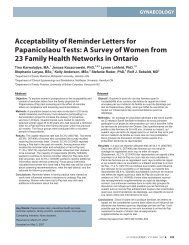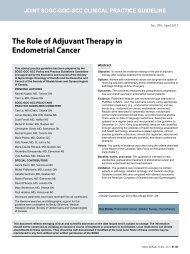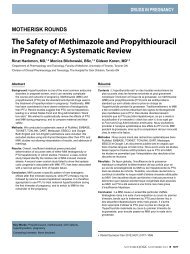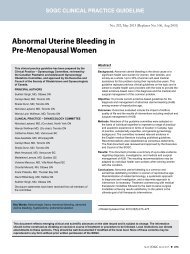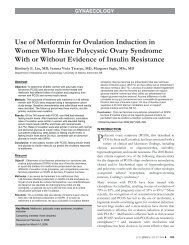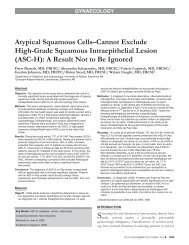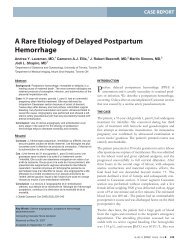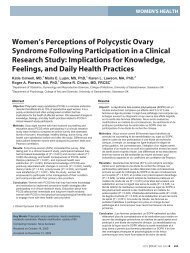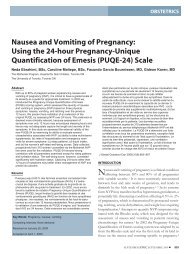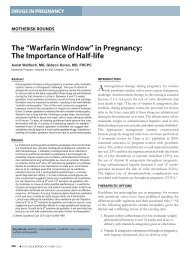Septic Uterus After Uterine Artery Embolization for Uterine ... - JOGC
Septic Uterus After Uterine Artery Embolization for Uterine ... - JOGC
Septic Uterus After Uterine Artery Embolization for Uterine ... - JOGC
You also want an ePaper? Increase the reach of your titles
YUMPU automatically turns print PDFs into web optimized ePapers that Google loves.
CASE REPORT<br />
CASE REPORT<br />
<strong>Septic</strong> <strong>Uterus</strong> <strong>After</strong> <strong>Uterine</strong> <strong>Artery</strong> <strong>Embolization</strong><br />
<strong>for</strong> <strong>Uterine</strong> Myomas Triggered by<br />
Endometrial Biopsy<br />
Shauna L. Reinblatt, MDCM, Srinivasan Krishnamurthy, MD, David Valenti, MD,<br />
Togas Tulandi, MD, MHCM<br />
Department of Obstetrics and Gynecology, and Radiology, McGill University, Montreal QC<br />
Abstract<br />
Background: Women who undergo uterine artery embolization<br />
(UAE) and subsequently have heavy vaginal bleeding require<br />
assessment to establish the cause. Endometrial sampling in such<br />
women should not necessarily carry more than the usual risk<br />
Cases: Two women who had undergone UAE presented with<br />
recurrence of heavy vaginal bleeding. In order to rule out possible<br />
endometrial malignancy, we per<strong>for</strong>med an endometrial biopsy.<br />
Both patients had large and necrotic intramural myomas adjacent<br />
to the endometrium. They developed septic uterus shortly after<br />
endometrial biopsy and each required a hysterectomy. The<br />
postoperative course in the first case was complicated by deep<br />
vein thrombosis and enterovaginal fistula.<br />
Conclusion: Because of the high risk of infection, women with a<br />
history of UAE and necrotic myoma adjacent to the endometrium<br />
should not undergo endometrial biopsy. We recommend<br />
evaluation of the relation of myomas to the endometrium.<br />
Résumé<br />
Contexte : Les femmes qui subissent une embolisation de l’artère<br />
utérine (EAU) et qui, par la suite, connaissent des saignements<br />
vaginaux abondants nécessitent une évaluation visant à en établir<br />
la cause. Chez ces femmes, le prélèvement endométrial ne<br />
devrait pas nécessairement s’accompagner de risques plus<br />
importants que la normale.<br />
Cas : Deux femmes qui avaient subi une EAU présentaient une<br />
récurrence de saignements vaginaux abondants. Afin d’écarter la<br />
présence possible d’une malignité endométriale, nous avons<br />
effectué une biopsie endométriale. Les deux patientes<br />
présentaient des myomes intramuraux importants et nécrosés<br />
adjacents à l’endomètre. Elles ont présenté un utérus septique<br />
peu après la biopsie endométriale; une hystérectomie s’est avérée<br />
nécessaire pour chacune d’entre elles. Dans le premier cas,<br />
l’évolution postopératoire a été compliquée par une thrombose<br />
veineuse profonde et une fistule entérovaginale.<br />
Conclusion : En raison des risques élevés d’infection, les femmes<br />
qui présentent des antécédents d’EAU et un myome nécrosé<br />
Key Words: <strong>Uterine</strong> artery embolization, septic uterus, myoma<br />
Competing Interests: None declared.<br />
Received on August 18, 2007<br />
Accepted on October 1, 2007<br />
adjacent à l’endomètre ne devraient pas subir une biopsie<br />
endométriale. Nous recommandons l’évaluation de la relation<br />
entre les myomes et l’endomètre.<br />
J Obstet Gynaecol Can 2008;30(4):344–346<br />
INTRODUCTION<br />
<strong>Uterine</strong> artery embolization is a useful treatment option<br />
<strong>for</strong> women with symptomatic uterine myoma. This<br />
procedure is associated with high success rates and low<br />
complication rates in appropriately selected patients. 1–4 The<br />
average reduction in the volume of the myoma is about<br />
30% to 50%, with improvement in the symptoms and<br />
menorrhagia in over 90% of patients. 1–4 Serious complications<br />
are rare. 3 We report severe uterine infection occurring<br />
at 10 and 16 days after endometrial biopsy in two women<br />
who had had UAE.<br />
THE CASES<br />
Case One<br />
A 54-year-old woman suffering from progressive<br />
menorrhagia and dysmenorrhea had transvaginal ultrasound<br />
and MRI that showed multiple myomas, with the<br />
largest intramural myoma measuring 7.8 7.7 8.3 cm.<br />
<strong>After</strong> discussion of treatment options, she consented to<br />
undergo UAE. This was per<strong>for</strong>med bilaterally without<br />
complications in May 2006. Her symptoms improved initially,<br />
but after several months vaginal bleeding again<br />
became irregular and heavy. Repeat MRI in November<br />
2006 showed complete necrosis of the myoma (Figure 1).<br />
Intimate contact between the myoma and the endometrium<br />
was seen.<br />
The patient returned in March 2007 with a complaint of<br />
excessive uterine bleeding in the past two months. In order<br />
to rule out endometrial pathology, an endometrial biopsy<br />
344 APRIL <strong>JOGC</strong> AVRIL 2008
<strong>Septic</strong> <strong>Uterus</strong> <strong>After</strong> <strong>Uterine</strong> <strong>Artery</strong> <strong>Embolization</strong> <strong>for</strong> <strong>Uterine</strong> Myomas Triggered by Endometrial Biopsy<br />
Figure 1. Magnetic resonance-coronal image showing<br />
intimate contact between a necrotic myoma and the<br />
endometrium<br />
Figure 2. Magnetic resonance imaging of a large<br />
intramural myoma with no visible myometrium separating<br />
the necrotic area and the endometrium<br />
was per<strong>for</strong>med. The histopathology of the specimen<br />
showed benign necrotic endometrium.<br />
Ten days later, the patient presented with abdominal pain,<br />
fever, and clinical evidence of sepsis. Transvaginal ultrasound<br />
examination showed the necrotic myoma and a posterior<br />
intramyometrial complex cystic mass suggestive of an<br />
abscess, measuring 11 9 10 cm. At exploratory<br />
laparotomy, a large pelvic abscess was found arising from<br />
the posterior aspect of the uterus and surrounded by<br />
adhesions to small bowel and omentum. The patient underwent<br />
total abdominal hysterectomy and bilateral salpingooophorectomy.<br />
The postoperative course was complicated by bilateral deep<br />
vein thrombosis and an enterovaginal fistula, which<br />
required three weeks of total parenteral nutrition and hospitalization.<br />
Histopathologic examination of the excised specimen<br />
revealed endometritis, salpingitis, and oophoritis. The<br />
uterus weighed 310 g and had an extensively hyalinized<br />
myoma.<br />
MRI<br />
UAE<br />
ABBREVIATIONS<br />
magnetic resonance imaging<br />
uterine artery embolization<br />
Case Two<br />
A 50-year-old woman underwent UAE in December 2006<br />
<strong>for</strong> menorrhagia with pressure symptoms. Transvaginal<br />
ultrasound and MRI per<strong>for</strong>med prior to UAE showed an<br />
enlarged uterus with several intramural myomas, the largest<br />
myoma measuring 10.5 8.7 11.4 cm. The image of a<br />
large intramural myoma with no visible myometrium separating<br />
the necrotic area and the endometrium is shown in<br />
Figure 2.<br />
In April 2007, the patient presented with vaginal discharge,<br />
painful cramping, and increasing uterine bleeding. An<br />
endometrial biopsy showed secretory endometrium. Her<br />
hemoglobin was 63 g/L, but the white blood cell count was<br />
normal. A repeat MRI showed that the largest myoma, originally<br />
intramural, had become submucous and had<br />
prolapsed into the uterine cavity. It measured 12 7.4 8.1 cm.<br />
Sixteen days later, the patient presented with urinary retention<br />
and foul-smelling vaginal discharge. Pelvic examination<br />
showed a large necrotic myoma distending the vagina.<br />
She underwent laparoscopic total hysterectomy and bilateral<br />
salpingo-oophorectomy, during which a large,<br />
foul-smelling, necrotic uterus with a large prolapsing<br />
myoma was found. The postoperative course was uneventful.<br />
The histopathology of the excised tissue demonstrated<br />
severe endomyometritis with microabscesses and a large<br />
infarcted myoma. The uterus weighed 287g.<br />
APRIL <strong>JOGC</strong> AVRIL 2008 345
CASE REPORT<br />
DISCUSSION<br />
<strong>Uterine</strong> artery embolization is an alternative to hysterectomy<br />
in women seeking treatment <strong>for</strong> symptomatic uterine<br />
myomas. It is associated with a good success rate in properly<br />
selected patients, with few major complications. The<br />
overall rate of serious complications after UAE, including<br />
infection and thrombotic events, is approximately 5%, 3<br />
most often occurring within three months of the procedure<br />
when patients are still being closely monitored <strong>for</strong><br />
symptoms. 5<br />
Our patients developed uterine sepsis at four and nine<br />
months after UAE, and at 10 and 16 days after endometrial<br />
sampling. Although the myomas were initially intramural,<br />
one of the myomas in the second case had become<br />
submucous when recurrence of symptoms was reported.<br />
This phenomenon occurs because the uterus becomes<br />
smaller after UAE, and the intramural myoma is <strong>for</strong>ced<br />
towards the uterine cavity. Submucous myomas carry a<br />
higher risk of becoming infected because they may prolapse<br />
and be exposed to the vaginal flora after becoming<br />
necrotic. 3–6 <strong>After</strong> UAE, uterine infection may be more common<br />
in the presence of submucous myoma. 4 In the cases<br />
described here, the endometrial biopsy appears to have triggered<br />
the infection, and the presence of a large and necrotic<br />
intramural myoma adjacent to the endometrium was a predisposing<br />
factor. <strong>Septic</strong> uterus is a serious condition; in fact,<br />
the first reported death following UAE was due to septic<br />
uterus. 7 The infection in our second case was limited to the<br />
uterus, whereas infection in the first case had spread beyond<br />
the uterus with development of pelvic abscesses. The subsequent<br />
surgery was difficult and complicated by injury to<br />
the bowel.<br />
In general, endometrial biopsy is associated with a minimal<br />
risk of complications. 8 However, the risk is high in the<br />
presence of necrotic tissue adjacent to or inside the uterine<br />
cavity. In retrospect, endometrial biopsy should not have<br />
been per<strong>for</strong>med. The optimal treatment in such patients is<br />
hysterectomy.<br />
CONCLUSION<br />
Because of the high risk of infection, women who have had<br />
UAE and present with necrotic myoma adjacent to the<br />
endometrium should not undergo endometrial biopsy. We<br />
recommend routine evaluation of the myoma in relation to<br />
the endometrium by means of imaging.<br />
REFERENCES<br />
1. Volkers NA, Hehenkamp WJ, Birnie E, de Vries C, Holt C, Ankum WM,<br />
et al. <strong>Uterine</strong> artery embolization in the treatment of symptomatic uterine<br />
myoma tumors (EMMY trial): periprocedural results and complications.<br />
J Vasc Intervent Radiol 2006;17:471–80.<br />
2. Pron G, Mocarski E, Cohen M, Colgan T, Bennett J, Common A, et al.<br />
Hysterectomy <strong>for</strong> complications after uterine artery embolization <strong>for</strong><br />
leiomyoma: results of a Canadian multicenter clinical trial. J Am Assoc<br />
Gynecol Laparosc 2003;10:99–106.<br />
3. Spies JB, Spector A, Roth AR, Baker CM, Mauro L, Murphy-Skrynarz K.<br />
Complications after uterine artery embolization <strong>for</strong> leiomyomas. Obstet<br />
Gynecol 2002;100:873–80.<br />
4. Al-Fozan H, Tulandi T. Factors affecting early surgical intervention after<br />
uterine artery embolization. Obstet Gynecol Surv 2002;57:810–5.<br />
5. Mehta H, Sandhu C, Matson M, Belli AM. Review of readmissions due to<br />
complications from uterine myoma embolization. Clin Radiol<br />
2002;57:1122–4.<br />
6. Ravina JH, Aymard A, Ciraru-Vigneron N, Clerissi J, Merland JJ. <strong>Uterine</strong><br />
fibroids embolization: results about 454 cases [article in French]. Gynecol<br />
Obstet Fertil 2003;31:597–605.<br />
7. Vashisht A, Studd J, Carey A, Burn P. Fatal septicaemia after myoma<br />
embolisation. Lancet 1999;354:307–8.<br />
8. ACOG Practice Bulletin number 74: Antibiotic prophylaxis <strong>for</strong> gynecologic<br />
procedures. Obstet Gynecol 108:225, 2006.<br />
346 APRIL <strong>JOGC</strong> AVRIL 2008



